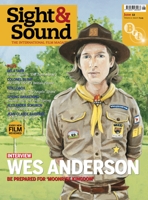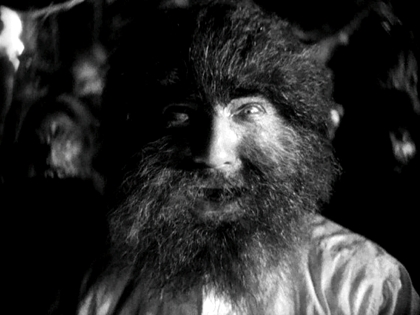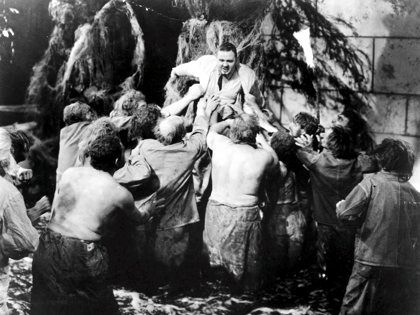Primary navigation


The 1932 film of H.G. Wells’s Dr Moreau story is disturbing and subtextually explosive, writes Michael Atkinson
from our June 2012 issue
The Island of Lost Souls
Erle C. Kenton; US 1932; Masters of Cinema / Region B Blu-ray and Region 2 DVD; 71 minutes; Aspect Ratio 1.37:1; Features: video interviews with Charles Laughton biographer Simon Callow and with film historian Jonathan Rigby, booklet with new essay by Kim Newman
Arguably the most disquieting and subtextually explosive of the 1930s Hollywood gout of horror adaptations, this misty hothouse Paramount classic acutely evokes the battery of qualmy ideas in H.G. Wells’s 1896 novel The Island of Dr Moreau: filthy secret jungle lairs, megalomaniac vivisectionist prophesying the ugliest Nazi experiments while mocking the new 19th-to-20th-century leaps in evolutionary biology and physiology, the disturbing dread of radical miscegenation obliterating our safe beliefs in the separation of human and animal. Erle C. Kenton’s film dives into this swamp head first, and no bigger compliment can be made to it than to say that the thematic ickiness of the film is intensified by its early-talkie mood and aura. (If the film had been made five years later, with the accompanying degree of polish, it would lose a good deal of its found-under-a-rock creepiness.) A year before Robert Armstrong made it to the humid primeval chaos of Skull Island in King Kong, we visit upon Dr Moreau (Charles Laughton) and his sweaty, overgrown enclave, peopled entirely by furry, bestial humanoids created in the lab out of imported animals, whose tribal community in the darkness eventually decides, after transgressions wrought by the doctor following the happenstantial presence of castaway Richard Arlen, that they’ve had enough of the good doctor’s House of Pain.
We know the story, juiced up here with the hero’s romance with a sultry and semi-feral Panther Woman (wherein a single kiss’s moment of arousal – with an animal – turns the man’s world upside-down), but the movie bristles with chilling moments and set pieces, from Laughton’s whip-cracking discipline over the zoological aberrations (“What is the Law?”) who pathetically respond in an all-too-convincing primal chant (“Are we not men?”), to the climactic turnabout of betrayal and scalpels, with Laughton screaming like no human had ever screamed on film before. Certainly, the fur-covered backs and briefly glimpsed mutations of ‘the natives’ remain profoundly unsettling. Watching the film, you have the distinctive sense of visiting a genuine social phobia, an exercising of centuries of human exceptionalism growing nauseated and sick by the reality of Darwinism and the rise of secular science, which privileges no meat puppet over any other. But in its careful depiction of the manimals’ own self-regard – they’ve been led to believe they’re the inheritors of a new evolutionary mantle, and when the lie is exposed the insurrection ignites – the film steps into sociopolitical waters that were just getting murky in Germany.

Well might we wonder where this slouching beast of a film came from, wicked enough in its day to warrant an outright ban from British censors. (It was banned as well in more than half a dozen other territories.) Its provenance is difficult to nail down: Kenton was an undistinguished journeyman despite some ‘Cahiers du cinéma’ attention in auteurism’s nascent heyday. (His best-known credits are divided between latter-stage entries in the Universal Frankenstein cycle and Abbott and Costello comedies.) No producer takes credit, perhaps due in some fashion to Paramount being on the brink of bankruptcy at the time, but the cinematographer was Karl Strauss (Sunrise) and screenwriters Philip Wylie (later to write When Worlds Collide) and Waldemar Young (a nimble jack-of-all-genres and Tod Browning vet) were certainly awake to the queasy implications of Wells’s story.
Indeed, the groundwork for such a conscientiously upsetting piece of work may have been set in Hollywood by the legacy of Browning, Lon Chaney and Young. (One should note that at least one of the multitude of Moreau’s uncredited Beast Men, Schlitze, as well as leading lady Leila Hyams, appeared that same year in Browning’s Freaks). It’s an overlooked and perverse secret detour running through the homogenised beginnings of Hollywood’s Golden Era – call it post-WWI body horror, running from Browning and Chaney’s The Unknown (1927) to 1935’s mutilative The Raven, after which its horrified impulses seemed to have been scrubbed from the growing industry’s docket.
Whoever the auteur, this remains by far the best Moreau film (and maybe the best Wells adaptation ever), capturing vividly the sense of the book’s ominous denouement, in which Wells’s protagonist, years later, tries to forget what he saw. But, occasionally, he says, “I look about me at my fellow man. And I go in fear.”
Long a musty old broadcast leftover, the film has been given the pristine restoration treatment, and not a moment too soon. The plethora of extras and interviews are great fun (among them an interview with Charles Laughton biographer Simon Callow, and a new essay on the film by Kim Newman). The Region 1 Criterion DVD/Blu-ray, released late last year in the same restoration as the Masters of Cinema disc, also boasted interviews with the founding members of Devo (consulted merely because of the band’s use of the “Are we not men?” catchphrase) waxing rhapsodic about the significance of the old film for alienated Ohio undergrads in the Nixon era.
The man with the scalpel: Kim Newman on mad movie plastic surgeons (September 2011)
Island of lost souls: Graham Fuller on Shutter Island (April 2010)
King Kong reviewed by Kim Newman (February 2006)
Hollow Man reviewed by David Thompson (October 2000)
The Mummy reviewed by Kim Newman (July 1999)